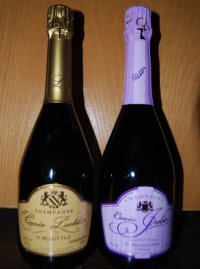|
Champagne Wine Region
While these elegant and oftentimes expensive wines of the Champagne wine region are often viewed as celebratory wines, just for special occasions, the best sparkling wines are much more than just that. They are exquisite wines with finesse, complexity, verve and personality which pair well with countless types of food and can age in a cool cellar for many years. The Champagne Wine Region: The Champagne region is located in northern France, a couple hours northeast of Paris. It is a cool region, one of the most northerly regions that produce wine in the world. For this reason, the grapes ripen slowly and retain a vibrant acidity which gives the wines lift and presence. The Champagne wine region is further subdivided into various areas and villages. Some areas are more known for growing red grapes and some more for white. Many Champagnes, particularly those from the bigger houses, are a blend of grapes from various regions. Some smaller production wines and wines from smaller, grower producers are from a single village or vineyard. The villages with the greatest vineyards are named grand cru, followed by premier cru, similar to Burgundy (although in Burgundy the designation applies to specific vineyards, not whole villages). You may see bottles labeled as Grand Cru if all the grapes come from within Grand Cru villages. Grape Varieties: Only certain grape varieties are allowed to be grown and used in the production of Champagne. The three most widely prevalent grapes in the Champagne wine region are Chardonnay (a white grape, the same that is famous for the white wines of Burgundy and as itself in California and other areas), Pinot Noir (a red grape, yes a red grape!, the same that produces the great red wines of Burgundy), and Pinot Meunier (another red grape relative of Pinot Noir). Many people are surprised to learn that many Champagne wines are made with red grapes, because the wines are almost always completely white. That is because the juice in red grapes is white. Red wines only get their color from prolonged exposure of the juice to the crushed skins of the grapes, where the color resides. In Champagne, the juice is pressed from the grapes and not allowed to pick up much of the color from the skins. That is why most Champagne is white, despite coming from both white and red grapes. The majority of Champagnes are made from a blend of two or more of the grapes grown in the region. However, some wines are made exclusively from white or red grapes. If a wine is labeled as Blanc de Blancs (literally "white of whites") then it is made from 100% Chardonnay. If a wine is labeled as Blanc de Noirs ("white of reds/blacks") then it is made from 100% red grapes (pinot noir and/or pinot meunier). How Are They Made? Champagne is made initially the same as other wines, the grapes are grown, harvested and fermented to a dry wine which is then aged for some period in barrels. However, rather than simply bottling the wine then, a few extra steps take place. The wine is bottled in special thick Champagne bottles but a small amount of sugar and yeast is added to the bottle. This sugar is fermented in bottle by the yeast, producing carbon dioxide and a bit of more alcohol. The carbon dioxide is dissolved in the wine and creates the carbonation, the bubbles that make Champagne unique. The bottles are then riddled, a slow process of moving them upright so that the yeast sediment collects in the neck of the bottle. When ready, the neck is then frozen and the frozen cube of wine containing the yeast is dispelled, called disgorgement, the wine is topped off and the bottle corked with a Champagne cork and metal cage. The small amount of wine that is added at disgorgement to top off the bottles, called the dosage, can vary from wine to wine. It typically includes a small amount of sugar which slightly sweetens the wine to balance it. The amount of sweetness is indicated by the names brut, sec, extra brut, brut nature, etc. Most Champagnes are towards the dry side but have a touch of residual sugar. Sweeter wines are called demi-sec. On other style of wine produced in the Champagne wine region deserves mention. Champagne Rosé is a sparkling wine which has some red color to it but is not dark red like a red wine. The Rosé color can come either from including some skin contact with the red grapes or from blending in some red, still wine into the blend. These pink Champagnes can vary in color but often have a fruitier, fuller flavor and body. How Do They Taste? The sparkling wines from the Champagne wine region is a seductive wine that is obviously unique because of its effervescence. It tends to have a crisp minerality running the length of the wine with bright acidity that gives it zip and freshness. It does not typically have ripe, juicy, fat fruit flavors like some white wines grown in warmer areas. The aromas can vary from citrus and fresh fruits to very mineral aromas of stones and oystershell, often accented by yeasty aromas like fresh dough, butter and bread. All that being said, Champanges can vary tremendously depending on the style, the types of grapes used, the region the grapes were grown and the particular producer's style. While some are lighter in body, lithe, silky and fine, others are richer, deeper, more burly and chunky. The Champange wine region is definitely worth exploring. Not just the homogenized, big house, ubiquitous Champagnes (Veuve Cliquot orange label anyone?), but all the unique, characterful wines being produced by small producers today. The variety is astonishing. Unfortunately, because the production of Champagne is so labor intensive and time consuming, the wines are rarely cheap. Many good value Champagnes can be found, but the best are often quite expensive. Return to the French Wine Regions section.  |



 Champagne, produced in the Champagne wine region, is the king of
Champagne, produced in the Champagne wine region, is the king of 


